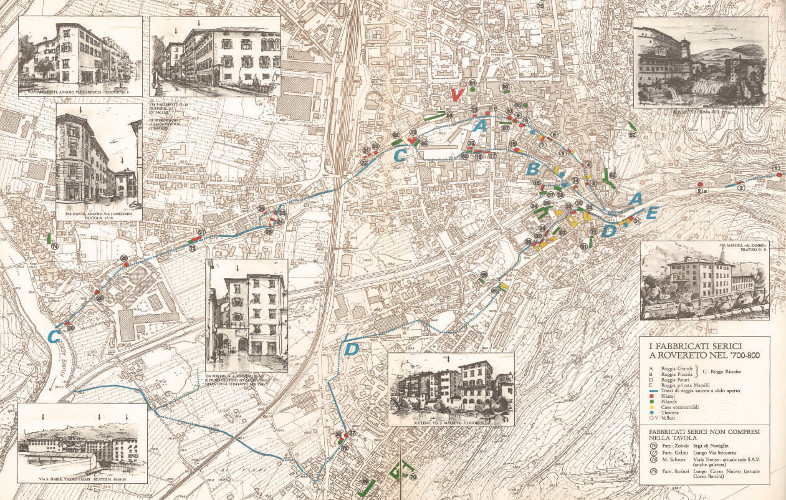Display board 3
THE LENO RIVER AND THE MILLRACES
Rovereto is closely related to the Leno river whose water has been used for centuries to irrigate the fields, transport wood and supply power for the water wheels of the mills and for other productive activities.
At the point where the Leno emerges from its valley, at the foot of the castle, three millraces were made.Then, from the C 17th the town developed right along their trajectories, outside the medieval walls. The out-flow works were concentrated in a locality known as "Zambel" from the dialect name for wooden locks.
The Great Millrace on the right bank of the river Leno was the oldest, cut inside the defensive wall of the C 14th to carry drinking water to the town. This crosses the historic centre passing through the Piazza della Podestà, via Portici e via Tartarotti, the ancient "Via delle Roze" (Millraces)
A second canal, known as the Small Millrace, was made in the C 16th again on the right side of the Leno, outside the city walls. This ran along the present via Calcinari (so-called for its lime kilns) and via Conciatori (the ancient quarter known for its gardens), crossed via Dante and ran alongside via Canestrini, then joined the previous canal and continued to Sacco with the name Rogge Riunite (United Millraces)
On the left bank of the Leno the Paiari Millrace was cut to serve Borgo di San Tommaso, now the quarter Santa Maria.
Maintenance of the industrial canals was managed by a consortium of the mill owners whose contributions to the expenses were in proportion to the size of their businesses. Since the quality of the water was fundamental for washing and dyeing the silk, the millraces were safeguarded by strict rules and regulations.
AN "INDUSTRIAL REVOLUTION"
In the course of the C 18th the production of the Rovereto businesses attained quite a high quality, prized on all the European markets. The demand for Roveretan silk thread increased exponentially and this regional capital acquired international prominence in the fields of silk production and commerce.
In a few decades the hydraulic mills were greatly improved to the point that they could work not only the local raw silk but also request further raw material from the Prince-Bishopric of Trento and the Venetian Republic.
As entrepreneurial activities in the silk sector continually increased a real "industrial revolution" was taking place ahead of its time, based on water power rather than steam.
In 1740 there were 23 reeling mills and by 1766 there were 36. In the same period the number of trading houses increased from 12 to 23. The population of Rovereto doubled over almost seventy years, going from 2,475 in 1700 to 5,139 in 1766. The population of the Rovereto district also doubled to over 15,000 units. Of these, about a third were employed in activities connected to silk manufacture. If the building works, making of machinery and related operations in the sericulture are all taken into account, it is easy to understand how the town's entire economy revolved around the production of silk thread. This particularly prosperous moment in the Roveretan economy resulted in a great building spree involving the enlargement, decoration and alteration of many palaces.
